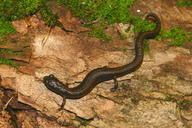|
Batrachoseps minor Jockusch, Yanev & Wake, 2001
Lesser Slender Salamander Subgenus: Batrachoseps | family: Plethodontidae subfamily: Hemidactyliinae genus: Batrachoseps |
 © 2008 William Flaxington (1 of 13) |
|
|
|
Description Distribution and Habitat Country distribution from AmphibiaWeb's database: United States U.S. state distribution from AmphibiaWeb's database: California
The type locality is a mesic canyon surrounded by relatively more xeric habitats. It was often found in shaded areas with abundant leaf litter. Trees include tanbark oak, coast live oak, blue oak, sycamore, and laurel, and abundant lower story vegetation dominated by poison oak. Species seems to be restricted to higher elevations and mesic regions. Trends and Threats Comments See another account at californiaherps.com.
References
Jockusch, E.L., Yanev, K.P., and Wake, D.B. (2001). ''Molecular phylogenetic analysis of slender salamanders, genus Batrachoseps (Amphibia: Plethodontidae), from central coastal California with descriptions of four new species.'' Herpetological Monographs, 15, 54-99. Originally submitted by: Brian Petirs (first posted 2001-09-25) Edited by: BP (added map), D. B. Wake (2004-04-05) Species Account Citation: AmphibiaWeb 2004 Batrachoseps minor: Lesser Slender Salamander <https://amphibiaweb.org/species/5867> University of California, Berkeley, CA, USA. Accessed May 30, 2025.
Feedback or comments about this page.
Citation: AmphibiaWeb. 2025. <https://amphibiaweb.org> University of California, Berkeley, CA, USA. Accessed 30 May 2025. AmphibiaWeb's policy on data use. |




 Raffaëlli Account
Raffaëlli Account Map of Life
Map of Life